Abstract
Background and aims
Crop residue decomposition is a major component of carbon (C) cycling and provides energy and nutrients to the soil micro-food web. An in-situ field experiment was conducted to examine how exogenous organic C is incorporated into the soil micro-food web and how this is influenced by four different fertilization treatments: organic manure (M), urea fertilizer (U), the combined application of organic and urea fertilizer (MU) and unfertilized control.
Methods
The amount of 13C-enriched maize remained was traced in microbial phospholipid fatty acids (PLFAs) and in different trophic groups of the soil nematode community after a 183-day decomposition period.
Results
The fertilization type influenced the incorporation of residue into the microbial community. Soil bacterial and fungal PLFAs utilized the least 13C-labeled crop residues in the U treatment. Both the nematode bacterial and the fungal pathways utilized more crop residues in the M treatment than in other treatments.
Conclusions
Given the ecological services provided by the soil organisms, our results suggest that long-term manure application increases the soil C pool directly. This also leads to more C from crop residues utilized by the soil food web, which in turn, can benefit crop growth or C accumulation in agroecosystems.




Similar content being viewed by others
References
Aciego Pietri JC, Brookes PC (2008) Relationships between soil pH and microbial properties in a UK arable soil. Soil Biol Biochem 40:1856–1861
Ahmad W, Jairajpuri MS (2010) Mononchida: the predaceous nematodes. Nematology monographs and perspectives, vol. 7. Brill Leiden-Boston, The Netherlands, pp 298
Albers D, Schaefer M, Scheu S (2006) Incorporation of plant C into the soil animal food web of an arable system. Ecology 87:235–245
Altieri MA (1999) The ecological role of biodiversity in agroecosystems. Agric Ecosyst Environ 74:19–31
An TT, Schaeffer S, Li SY, Fu SF, Pei JB, Li H, Zhuang J, Radosevich M, Wang JK (2015) C fluxes from plants to soil and dynamics of microbial immobilization under plastic film mulching and fertilizer application using 13C pulse-labeling. Soil Biol Biochem 80:53–61
Bach EM, Baer SG, Meyer CK, Six J (2010) Soil texture affects soil microbial and structural recovery during grassland restoration. Soil Biol Biochem 42:2182–2191
Bardgett RD, Wardle DA (2010) Aboveground-belowground linkages: biotic interactions, ecosystem processes, and global change. Oxford University Press, New York, USA
Bjørnlund L, Rønn R (2008) “David and Goliath” of the soil food web e flagellates that kill nematodes. Soil Biol Biochem 40:2032–2039
Blaud A, Lerch T, Chevallier T, Nunan N, Chenu C, Brauman A (2012) Dynamics of bacterial communities in relation to soil aggregate formation during the decomposition of 13C-labelled rice straw. Appl Soil Ecol 53:1–9
Bongers T (1994) De Nematoden van Nederland: Vormgeving en technische realisatie. Uitgeverij Pirola, Schoorl, Netherlands
Bossio DA, Scow KM (1995) Impact of C and flooding on the metabolic diversity of microbial communities in soils. Appl Environ Microbiol 61:4043–4050
Bouwman LA, Zwart KB (1994) The ecology of bacterivorous protozoans and nematodes in arable soil. Agric Ecosyst Environ 51:145–160
Briar SS, Grewal PS, Somasekhar N, Stinner D, Miller SA (2007) Soil nematode community, organic matter, microbial biomass and nitrogen dynamics in field plots transitioning from conventional to organic management. Appl Soil Ecol 37:256–266
Briar SS, Fonte SJ, Park I, Six J, Scow K, Ferris H (2011) The distribution of nematodes and soil microbial communities across soil aggregate fractions and farm management systems. Soil Biol Biochem 43:905–914
Caravaca F, Masciandaro G, Ceccanti B (2002) Land use in relation to soil chemical and biochemical properties in a semiarid Mediterranean environment. Soil Tillage Res 68:23–30
Carrillo Y, Ball BA, Bradford MA, Jordan CF, Molina M (2011) Soil fauna alter the effects of litter composition on nitrogen cycling in a mineral soil. Soil Biol Biochem 43:1440–1449
Chahartaghi M, Langel R, Scheu S, Ruess L (2005) Feeding guilds in Collembola based on nitrogen stable isotope ratios. Soil Biol Biochem 37:1718–1725
Chu HY, Lin XG, Fujii T, Morimoto S, Yagi K, Hu JL, Zhang JB (2007) Soil microbial biomass, dehydrogenase activity, bacterial community structure in response to long-term fertilizer management. Soil Biol Biochem 39:2971–2976
Crotty FV, Blackshaw RP, Adl SM, Inger R, Murray PJ (2014) Divergence of feeding channels within the soil food web determined by ecosystem type. Ecol Evol 4:1–13
De Mesel I, Derycke S, Moens T, Van Der Gucht K, Vincx M, Swings J (2004) Top-down impact of bacterivorous nematodes on the bacterial community structure: a microcosm study. Environ Microbiol 6:733–744
de Troyer I, Amery F, Van Moorleghem C, Smolders E, Merckx R (2011) Tracing the source and fate of dissolved organic matter in soil after incorporation of a 13C labelled residue: a batch incubation study. Soil Biol Biochem 43:513–519
de Vries FT, Caruso T (2016) Eating from the same plate? Revisiting the role of labile C inputs in the soil food web. Soil Biol Biochem 102:4–9
de Vries FT, Thébault E, Liiri M, Birkhofer K, Tsiafouli MA, Bjørnlund L, Jørgensen HB, Brady MV, Christensen S, de Ruiter PC (2013) Soil food web properties explain ecosystem services across European land use systems. Proc Natl Acad Sci 110:14296–14301
Denef K, Bubenheim H, Lenhart K, Vermeulen J, Van Cleemput O, Boeckx P, Müller C (2007) Community shifts and C translocation within metabolically-active rhizosphere microorganisms in grasslands under elevated CO2. Biogeosciences 4:769–779
Denef K, Roobroeck D, Wadu MCM, Lootens P, Boeckx P (2009) Microbial community composition and rhizodeposit-C assimilation in differently managed temperate grassland soils. Soil Biol Biochem 41:144–153
Derrien D, Marol C, Balabane M, Balesdent J (2006) The turnover of carbohydrates in a cultivated soil estimated by 13C natural abundances. Eur J Soil Sci 57:547–557
Dungait J, Kemmitt S, Michallon L, Guo S, Wen Q, Brookes P, Evershed R (2011) Variable responses of the soil microbial biomass to trace concentrations of 13C-labelled glucose, using 13C-PLFA analysis. Eur J Soil Sci 62:117–126
Elfstrand S, Lagerlöf J, Hedlund K, Mårtensson A (2008) C routes from decomposing plant residues and living roots into soil food webs assessed with 13C labelling. Soil Biol Biochem 40:2530–2539
FAO-UNESCO (1988) Soil Map of the World, Revised Legend. FAO World Soil Resources Report No. 60. Food and Agricultural Organization of the United Nations, UNESCO, Rome, Italy, pp 199
Ferris H, Venette RC, van der Meulen HR, Lau SS (1998) Nitrogen mineralization by bacterial-feedingnematodes: verification and measurement. Plant Soil 203:159–171
Ferris H, Bongers T, De Goede RGM (2001) A framework for soil food web diagnostics: extension of the nematode faunal analysis concept. Appl Soil Ecol 18:13–29
Fierer N, Strickland MS, Liptzin D, Bradford MA, Cleveland CC (2009) Global patterns in belowground communities. Ecol Lett 12:1238–1249
Fisk MC, Schmidt SK (1996) Microbial responses to nitrogen additions in alpine tundra soil. Soil Biol Biochem 28:751–755
Fontaine S, Mariotti A, Abbadie L (2003) The priming effect of organic matter: a question of microbial competition? Soil Biol Biochem 35:837–843
Frey S, Drijber R, Smith H, Melillo J (2008) Microbial biomass, functional capacity, and community structure after 12 years of soil warming. Soil Biol Biochem 40:2904–2907
Gebremikael MT, Steel H, Buchan D, Bert W, De Neve S (2016) Nematodes enhance plant growth and nutrient uptake under C and N-rich conditions. Sci Rep 6:32862
Gomez J, Denef K, Stewart C, Zheng J, Cotrufo MF (2014) Biochar addition rate influences soil microbial abundance and activity in temperate soils. Eur J Soil Sci 65:28–39
Holtkamp R, Kardol P, van der Wal A, Dekker SC, van der Putten WH, de Ruiter PC (2008) Soil food web structure during ecosystem development after land abandonment. Appl Soil Ecol 39:23–34
Hunt H, Coleman D, Ingham E, Ingham RE, Elliott E, Moore J, Rose S, Reid C, Morley C (1987) The detrital food web in a shortgrass prairie. Biol Fertil Soils 3:57–68
Ingham RE, Trofymov JA, Ingham ER, Coleman DC (1985) Interaction of bacteria, fungi, and their nematode grazers: effects on nutrient cycling and plant growth. Ecol Monogr 55(1):119–140
Kohl L, Laganière J, Edwards KA, Billings SA, Morrill PL, Van Biesen G, Ziegler SE (2015) Distinct fungal and bacterial δ13C signatures as potential drivers of increasing δ13C of soil organic matter with depth. Biogeochemistry 124:13–26
Kramer C, Gleixner G (2006) Variable use of plant- and soil-derived carbon by microorganisms in agricultural soils. Soil Biol Biochem 38:3267–3278
Kudrin AA, Tsurikov SM, Tiunov AV (2015) Trophic position of microbivorous and predatory soil nematodes in a boreal forest as indicated by stable isotope analysis. Soil Biol Biochem 86:193–200
Langel R, Dyckmans J (2014) Combined 13C and 15N isotope analysis on small samples using a near-conventional elemental analyzer/isotope ratio mass spectrometer setup. Rapid Commun Mass Spectrom 28:1019–1022
Leroy BL, De Sutter N, Ferris H, Moens M, Reheul D (2009) Short-term nematode population dynamics as influenced by the quality of exogenous organic matter. Nematology 11:23–38
Liang WJ, Lou YL, Li Q, Zhong S, Zhang XK, Wang JK (2009) Nematode faunal response to long-term application of nitrogen fertilizer and organic manure in Northeast China. Soil Biol Biochem 41:883–890
Liu T, Whalen JK, Shen QR, Li HX (2016) Increase in soil nematode abundance due to fertilization was consistent across moisture regimes in a paddy rice–upland wheat system. Eur J Soil Biol 72:21–26
Lundgren JG, Ellsbury ME, Prischmann DA (2009) Analysis of the predator community of a subterranean herbivorous insect based on polymerase chain reaction. Ecol Appl 19(8):2157–2166
Mikola J, Setälä H (1998) Productivity and trophic-level biomasses in a microbial-based soil food web. Oikos 82:158–168
Moore JC, McCann K, de Ruiter PC (2005) Modeling trophic pathways, nutrient cycling, and dynamic stability in soils. Pedobiologia 49:499–510
Neher DA (2010) Ecology of plant and free-living nematodes in natural and agricultural soil. Annu Rev Phytopathol 48:371–394
Neher DA, Barbercheck ME, El-Allaf SM, Anas O (2003) Effects of disturbance and ecosystem on decomposition. Appl Soil Ecol 23:165–179
Neher DA, Wu JH, Barbercheck ME, Anas O (2005) Ecosystem type affects interpretation of soil nematode community measures. Appl Soil Ecol 30:47–64
O'Lear H, Seastedt T, Briggs J, Blair J, Ramundo R (1996) Fire and topographic effects on decomposition rates and N dynamics of buried wood in tallgrass prairie. Soil Biol Biochem 28:323–329
Oostenbrink M (1960) Estimating nematode populations by some selected methods. In: Sasser, J.N., Jenkins, W.R. (Eds.), Nematology University of North Carolina Press, Chapel Hill
Ostle N, Briones M, Ineson P, Cole L, Staddon P, Sleep D (2007) Isotopic detection of recent photosynthate C flow into grassland rhizosphere fauna. Soil Biol Biochem 39:768–777
Pan FX, Li YY, Chapman SJ, Khan S, Yao HY (2016) Microbial utilization of rice straw and its derived biochar in a paddy soil. Sci Total Environ 559:15–23
Pausch J, Kramer S, Scharroba A, Scheunemann N, Butenschoen O, Kandeler E, Marhan S, Riederer M, Scheu S, Kuzyakov Y (2015) Small but active-pool size does not matter for C incorporation in below-ground food webs. Funct Ecol 30:479–489
Pausch J, Hofmann S, Scharroba A, Kuzyakov Y, Ruess L (2016) Fluxes of root-derived C into the nematode micro-food web of an arable soil. Food Webs 9:32–38
Persson T, Bååth E, Clarholm M, Lundkvist H, Söderström BE, Sohlenius B (1980) Trophic structure, biomass dynamics and C metabolism of soil organisms in a scots pine forest. In: Persson T (ed) Structure and function of northern coniferous forests-an ecosystem study, pp 419–460
Peterson BJ, Fry B (1987) Stable isotopes in ecosystem studies. Annu Rev Entomol Syst 18:293–320
Pollierer MM, Langel R, Körner C, Maraun M, Scheu S (2007) The underestimated importance of belowground C input for forest soil animal food webs. Ecol Lett 10:729–736
Reed H, Blair J, Wall D, Seastedt T (2009) Impacts of management legacies on litter decomposition in response to reduced precipitation in a tallgrass prairie. Appl Soil Ecol 42:79–85
Ros M, Pascual J, Garcia C, Hernandez M, Insam H (2006) Hydrolase activities, microbial biomass and bacterial community in a soil after long-term amendment with different composts. Soil Biol Biochem 38:3443–3452
Rubino M, Dungait J, Evershed R, Bertolini T, De Angelis P, D’Onofrio A, Lagomarsino A, Lubritto C, Merola A, Terrasi F (2010) C input belowground is the major C flux contributing to leaf litter mass loss: evidences from a 13C labelled-leaf litter experiment. Soil Biol Biochem 42:1009–1016
Ruess L, Ferris H (2004) Decomposition pathways and successional changes. Nematol Monogr Perspect 2:547–556
Sánchez-Moreno S, Ferris H, Young MA, Culman SW, Jackson LE (2011) Abundance, diversity and connectance of soil food web channels along environmental gradients in an agricultural landscape. Soil Biol Biochem 43:2374–2383
Sauheitl L, Glaser B, Bol R (2005) Short-term dynamics of slurry-derived plant and microbial sugars in a temperate grassland soil as assessed by compound-specific delta C-13 analyses. Rapid Commun Mass Spectrom 19:1437–1446
Six J, Frey S, Thiet R, Batten K (2006) Bacterial and fungal contributions to C sequestration in agroecosystems. Soil Sci Soc Am J 70:555–569
Tavi NM, Martikainen PJ, Lokko K, Kontro M, Wild B, Richter A, Biasi C (2013) Linking microbial community structure and allocation of plant-derived C in an organic agricultural soil using 13CO2 pulse-chase labelling combined with 13C-PLFA profiling. Soil Biol Biochem 58:207–215
ter Braak, CJF, Šmilauer P (2012) Canoco Reference Manual and User's Guide: Software for Ordination (Version 5.0). Microcomputer Power, Ithaca, NY, USA, pp 151–230
Townshend JL (1963) A modification and evaluation of the apparatus for the Oostenbrink direct cotton wool filter extraction method. Nematologica 9:106–110
Ugarte CM, Zaborski ER, Wander MM (2013) Nematode indicators as integrative measures of soil condition in organic cropping systems. Soil Biol Biochem 64:103–113
von Lützow M, Kögel-Knabner I, Ekschmitt K, Matzner E, Guggenberger G, Marschner B, Flessa H (2006) Stabilization of organic matter in temperate soils: mechanisms and their relevance under different soil conditions-a review. Eur J Soil Sci 57:526–545
Wang C, Lu XK, Taiki M, Mao QG, Zhou KJ, Zhou GY, Nie YX, Mo JM (2018) Responses of soil microbial community to continuous experimental nitrogen additions for 13 years in a nitrogen-rich tropical forest. Soil Biol Biochem 121:103–112
Yeates G, Bongers T, De Goede R, Freckman D, Georgieva S (1993) Feeding habits in soil nematode families and genera-an outline for soil ecologists. J Nematol 25:315–331
Yevdokimov I, Ruser R, Buegger F, Marx M, Munch JC (2006) Microbial immobilisation of 13C rhizodeposits in rhizosphere and root-free soil under continuous 13C labelling of oats. Soil Biol Biochem 38:1202–1211
Zhang HJ, Ding WX, Yu HY, He XH (2013) Carbon uptake by a microbial community during 30-day treatment with 13C-glucose of a sandy loam soil fertilized for 20 years with NPK or compost as determined by a GC–C–IRMS analysis of phospholipid fatty acids. Soil Biol Biochem 57:228–236
Acknowledgements
This manuscript greatly benefitted from the insightful comments from two reviewers. This research was supported by the National Natural Science Foundation of China (31330011), the National Key Research and Development Plan (2016YFD0300204 and 2017YFD0200602), the National Natural Science Foundation of China (41771280) and the Chinese Academy of Sciences Visiting Professorship Program for Senior International Scientists (2017VCA0004).
Author information
Authors and Affiliations
Corresponding authors
Additional information
Responsible Editor: Feike A. Dijkstra.
Electronic supplementary material
ESM 1
(DOC 72 kb)
Rights and permissions
About this article
Cite this article
Cui, S., Liang, S., Zhang, X. et al. Long-term fertilization management affects the C utilization from crop residues by the soil micro-food web. Plant Soil 429, 335–348 (2018). https://doi.org/10.1007/s11104-018-3688-4
Received:
Accepted:
Published:
Issue Date:
DOI: https://doi.org/10.1007/s11104-018-3688-4




